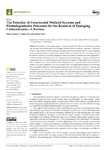The Potential of Constructed Wetland Systems and Photodegradation Processes for the Removal of Emerging Contaminants—A Review

Use este enlace para citar
http://hdl.handle.net/2183/31844
A non ser que se indique outra cousa, a licenza do ítem descríbese como Atribución 4.0 Internacional (CC BY 4.0)
Coleccións
- GI-EnQA-Artigos [16]
Metadatos
Mostrar o rexistro completo do ítemTítulo
The Potential of Constructed Wetland Systems and Photodegradation Processes for the Removal of Emerging Contaminants—A ReviewData
2022Cita bibliográfica
Sánchez, M.; Ruiz, I.; Soto, M. The Potential of Constructed Wetland Systems and Photodegradation Processes for the Removal of Emerging Contaminants—A Review. Environments 2022, 9, 116. https://doi.org/10.3390/environments9090116
Resumo
[Abstract] The presence of emerging organic contaminants (EOCs) in the environment is increasing and requires the development of technologies for their effective removal. Therefore, a literature review on the behavior of EOCs during municipal wastewater treatment, both in major treatment systems and particularly in constructed wetlands (CWs), was carried out. The study also reviewed the behavior of EOCs in anaerobic digesters (ADs) and advanced oxidation processes, particularly in TiO2-based photocatalysis, which are being proposed as promising pre- and post-treatments for combination with CW. The following ten compounds were screened: acetaminophen (ACE), ofloxacin (OFL), caffeine (CAF), carbamazepine (CBZ), ketoprofen (KET), ibuprofen (IBU), diclofenac (DCL), clofibric acid (ACB), bisphenol A (BPA), and sotalol (SOT). The degradation pathways of the selected EOCs are largely influenced by their physicochemical and biochemical properties. Sorption and biodegradation are the main elimination mechanisms found in AD and CW treatment systems, where the combination of anaerobic and aerobic environments improves the elimination efficiency of EOCs. However, various contaminants appear recalcitrant. In this sense, in combination with CWs, TiO2-based photocatalysis emerges as a promising post-treatment for advanced EOC removal from wastewater.
Palabras chave
Emerging organic contaminants
Constructed wetlands
Anaerobic digesters
Photocatalysis
TiO2
Removal mechanisms
Removal efficiency
Constructed wetlands
Anaerobic digesters
Photocatalysis
TiO2
Removal mechanisms
Removal efficiency
Descrición
This article belongs to the Topic Soil and Water Pollution Process and Remediation Technologies
Versión do editor
Dereitos
Atribución 4.0 Internacional (CC BY 4.0)
ISSN
2076-3298






